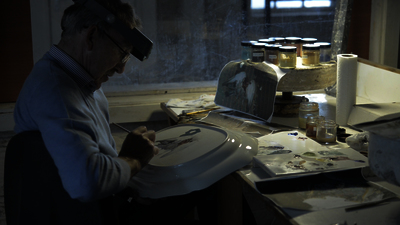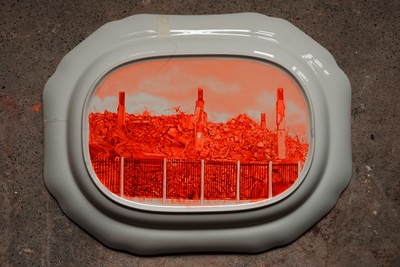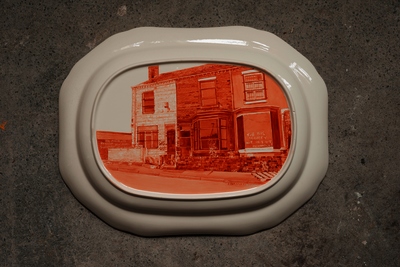BROWNSWORD, Neil (2014) National Treasure (2014 -2019). [Artefact]
1. National Treasure, 2014, film loop. 15 min 49.mov - Supplemental Material
Available under License Type All Rights Reserved.
Download (419MB)
![[thumbnail of 1.1. National Treasure, looped film ( Anthony Challinor]](https://eprints.staffs.ac.uk/5686/1.hassmallThumbnailVersion/1.1.%20National%20Treasure%2C%20looped%20film%20%28%20Anthony%20Challinor..jpg)

1.1. National Treasure, looped film ( Anthony Challinor..jpg - Supplemental Material
Available under License Type All Rights Reserved.
Download (943kB) | Preview
![[thumbnail of 2. National Treasure. Painting completed by Anthony Challinor 2014.]](https://eprints.staffs.ac.uk/5686/2.hassmallThumbnailVersion/2.%20National%20Treasure.%20Painting%20completed%20by%20Anthony%20Challinor%202014pg.jpg)

2. National Treasure. Painting completed by Anthony Challinor 2014pg.jpg - Supplemental Material
Available under License Type All Rights Reserved.
Download (1MB) | Preview
![[thumbnail of 3. National Treasure. Painting completed by Anthony Challinor 2014]](https://eprints.staffs.ac.uk/5686/3.hassmallThumbnailVersion/3.%20National%20Treasure.%20Painting%20completed%20by%20Anthony%20Challinor%202014.jpg)

3. National Treasure. Painting completed by Anthony Challinor 2014.jpg - Supplemental Material
Available under License Type All Rights Reserved.
Download (5MB) | Preview
4. National Treasure. Painting completed by Anthony Challinor 2015.JPG - Supplemental Material
Available under License Type All Rights Reserved.
Download (6MB) | Preview
5. National Treasure. Painting completed by Anthony Challinor 2016.JPG - Supplemental Material
Available under License Type All Rights Reserved.
Download (2MB) | Preview
6. National Treasure. Painting completed by Anthony Challinor 2016. JPG.JPG - Supplemental Material
Available under License Type All Rights Reserved.
Download (6MB) | Preview
Abstract or description
Ongoing iterations of National Treasure remediate actions and traces from earlier fieldwork, and a series of site-specific performative interventions during the exhibition ‘Vociferous Void’ (British Ceramics Biennial 27/09 – 10/11/ 2013) into a film and object-based installation. It explores critical insights into aspects of skill displacement following several decades of industrial change in North Staffordshire’s ceramic sector. Its title ironically draws upon East Asian cultural value systems assigned to individuals who have attained high levels of artistry to ensure the preservation and continuation of their traditions. Research underpinning National Treasure has been disseminated via conferences including the International Academy of Ceramics 46th General Assembly, Dublin; explored by international critics/writers including Vieteberg, Dahn and Wiggers discussing new directions in ceramic practice. As one of 2629 entries by 1470 applicants from 74 countries, a panel of eminent judges ‘unanimously’ awarded National Treasure the Grand Prize at the Gyeonggi International Ceramic Biennale (GICB) a prestigious accolade in contemporary ceramics, in recognition for Brownsword’s ‘creativity and contribution to the field’.
Looped projection (15 mins 49 secs – filmed 23 June 2014), workstation, residues of china painting, repainted platters salvaged from the Spode factory, live performance.
| Item Type: | Artefact |
|---|---|
| Additional Information: | National Treasure (artefact) examines shifts in production from the ‘shop floor’ to the factory tourism model, through an innovative combination of live performance, installation, social practice, film and artefact that ‘bring the traditions of the [ceramics] field into a new category of experience’. Brownsword’s parody of this ‘artisan on display’ format, critiques how the parade of ‘indigenous’ artisanal craft from the visitor centre experience, obscures the realities of profit first strategies of mass-automation and global outsourcing. An ex-industry China painter was employed by Brownsword to follow the genre of the romantic ruin commonly depicted in 18th century British ceramics. Painting on the backs of discarded platters found at former historic sites of production (where traditionally each artisan would sign their work), with images that documented Stoke-on-Trent’s post-industrial fallout, offered a new perspective to social realism within ceramic practice. The filmic component of the work documents an ex-china painter, re-employed to paint scenes of post-industrial decay in the now derelict spaces of the former Spode factory in Stoke-on-Trent (filmed 23 June 2014). The work comments upon the value and displacement of intangible cultural heritage (ICH) in North Staffordshire’s ceramic industry. Through its varied locations, the installation is often activated with intermittent live performances set out to subvert passive spectator consumption through the backdrop of the film narrative and subjects being painted. By incorporating the dynamics of hired labour, National Treasure offered an inventive method to elevate and disseminate the endangered practices of a rapidly disappearing culture of labour. The work also explored the ethical implications of appropriating people and their skill as a raw material – a subject relatively absent in contemporary ceramic practice. |
| Faculty: | School of Creative Arts and Engineering > Art and Design |
| Depositing User: | Neil BROWNSWORD |
| Date Deposited: | 05 Jun 2019 12:53 |
| Last Modified: | 24 Feb 2023 13:56 |
| URI: | https://eprints.staffs.ac.uk/id/eprint/5686 |

 Tools
Tools Tools
Tools